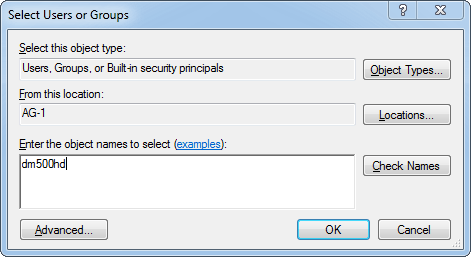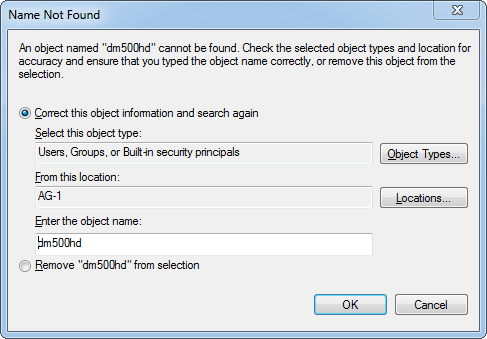10
2
I created a new standard user account named dm500hd-ag1 on a Windows 7 Ultimate PC. The name of the host computer is ag1 so I thought I would add that in the name of the user account name.
Then I changed my mind, and i said to myself... eh what the hell, I'll just dub it dm500hd and be happy with it. So I went back to the Control Panel and I changed the user account name. All done and well, no errors reported.

I intend to use this account to share a local disk drive with my Dreambox STB. Initially, my idea was to add the "ag-1" suffix in the name to distinguish the user account name from the share name.
So in Windows Explorer, I clicked on all the right buttons and I got to the "Select Users or Groups" dialog where I'm supposed to enter the name of the user account name and click the "Check Names" button.

Except when I click the button I get the "Name Not Found" dialog.
An object named "dm500hd" cannot be found. Check the selected object types and location for accuracy and ensure that you typed the object name correctly, or remove this object from the selection.

Oh boy... can't find the fricking it just created. Well okay, it renamed an existing name... but what difference does it make? Doesn't the word "rename" mean the same thing in the Windows world and in all of its subsystems, as it does in the real world?
So my best guess... is that it still recognizes this account as dm500hd-ag1. What do you think? Let's try it, shall we? So I input dm500hd-ag1 and click the "Check Names" button again, and it works!

Well would you look at that... sun of a b....
Have I powered it off and on again you say? Yes, that was my first thought. I logged out of my admin account and logged in as the new dm500hd standard user. There's currently no password for this one yet. It logged me in straight away, prepped the desktop and everything. I logged out, and logged back into my admin account to try this again. It was a no go. So I rebooted the system, hoping it would fresh up its memory and its fricking mind and realize what the new user account name is. Nope! It didn't...
So the user account name titled dm500hd that is being displayed on the Control Panel is just for the show then? It's not really the name of the account, am I right? So it didn't really do anything, it didn't rename the account?
How do I get this dinosaur of a system to do what I tell it to do?... How do I REALLY change my account name?
Also consider the profile folder (C:\Users\[Username]) – that is actually completely separate from the account name, and can be changed by logging in with another account, renaming the directory and changing the relevant ProfileImagePath registry key in HKLM\SOFTWARE\Microsoft\Windows NT\CurrentVersion\ProfileList\[User ID]. – ntoskrnl – 2014-02-17T00:11:01.710